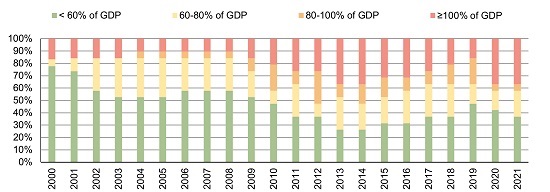Announcements
Drinks
Euro area: reform of fiscal rules, return of market discipline to support fiscal consolidation
By Giulia Branz, Senior Analyst, and Thibault Vasse, Associate Director
The European Commission’s proposal for EU fiscal framework reform, outlined on 9 November, is an important step towards rules that account for differences across EU member states while promoting economic stabilisation and investment to support growth and facilitate the green and digital transitions, though challenges remain.
The EU fiscal framework has suffered from multiple shortcomings since the Stability and Growth Pact was last reformed almost a decade ago. Existing rules have helped avoid unbridled fiscal slippage, but they have not prevented the build-up of fiscal vulnerabilities or pro-cyclical fiscal policies in many countries. Compliance has been poor, averaging 50% over 1998-21 (Figure 1) for the euro area with stark differences between countries.
Figure 1: Average euro area (EA) fiscal rule compliance scores, 1998-21
% of rules and years in compliance
Source: European Fiscal Board, Scope Ratings
The proposed new framework aims at enhancing transparency and enforceability by focusing fiscal adjustments on a single, observable variable: net primary expenditure (spending net of interest, discretionary revenue measures and cyclical unemployment costs). This is an improvement on the current system that relies on unobserved potential GDP-based variables challenged by mismeasurement and revisions.
The European Commission would present reference, multi-year fiscal adjustment paths that match member states’ respective fiscal positions, underpinned by comprehensive debt sustainability analyses. Each country would then present multi-annual fiscal and economic adjustment plans, which could be lengthened if backed by reforms and investments that support debt sustainability and common EU policy priorities such as addressing climate change. National plans would need to be endorsed by the European Council, enhancing the commitment each country makes to achieve the desired fiscal targets.
Specifics of EU plan still to be clarified
There remain uncertainties as to the specifics of the proposal, which will take months to be finalised, given divergent views on the degree of change to be introduced.
Enforcement mechanisms have been strengthened, through the introduction of reputational costs, more practical financial sanctions and conditions attached to EU funding. Their effectiveness, however, may be hampered by the significant discretion introduced by abandoning common targets in favour of country-specific multiannual plans.
Risks of interjurisdictional conflicts between national governments and the Commission remain, as Brussels would retain a primary role in steering euro area fiscal policies. On the other hand, weakening the role of the Commission would have likely had adverse effects on the enforceability of the framework.
Ensuring the new framework delivers better outcomes is critical. Debt sustainability risks have increased since the start of the Covid-19 pandemic and are compounded by higher interest rates, given a third of euro area governments have debt above 100% of GDP, up from around a sixth in 2000 (Figure 2).
Figure 2: Rising share of euro area countries with high debt ratios (% of total)

Note: Countries with debt-to-GDP ratios above 100% include Belgium, Cyprus, Greece, Spain, France, Italy, and Portugal; Source: Eurostat, Scope Ratings
In the meantime, the return of market discipline will help prevent excessive fiscal loosening. Market discipline is acting on two fronts: higher financing costs and the halt of net asset purchases from the ECB, imposing more reliance on, and scrutiny from, private investors.
Financing costs in the euro area have markedly increased since the beginning of the year. The estimated euro area 10-year government benchmark yield rose to 2.9% in November 2022 from 0.3% in December 2021. Higher financing rates are eroding fiscal space, though this is cushioned by euro area sovereigns’ favourable debt structures. Euro area interest payments as a share of GDP should increase by 0.4pps between 2021 and 2024 and are likely to continue rising thereafter (Figure 3).
Figure 3: Interest payment burden in the euro area
% (LHS), EUR bn (RHS)
Source: AMECO, Macrobond, Scope Ratings
The halt of net asset purchases requires private investors to fund deficits to a larger extent than in recent years. ECB net purchases of euro area government bonds have outpaced aggregate budget deficits every year since 2015 except in 2019. This will change by this year, however, in a context of wider deficits (Figure 4), though the ECB will continue to play a crucial supportive role in sovereign bond markets by only gradually winding down its holdings, now at more than 25% of public debt of most euro area members.
Figure 4: Euro area net borrowing and ECB net asset purchases
EUR bn

Note: ECB net purchases comprise net asset purchases of euro area government bonds under the PSPP and the PEPP. Source: ECB, AMECO, Macrobond, Scope Ratings
The pressure for fiscal consolidation unfortunately coincides with slowing economic growth and risks of short-run technical recessions due to shocks caused by Russia’s war in Ukraine. Governments will have to strike a delicate balance between supporting near-term growth and ensuring long-run fiscal sustainability, hence the importance of a revised fiscal framework that ensures fiscal buffers are rebuilt in good times to counter future shocks.
In this context, the revamped euro area financial architecture provides an important backstop. Euro area economies will be supported by the Next Generation EU funds for public investments without explicitly burdening government finances. In addition, the ECB’s Transmission Protection Instrument could help prevent excessive financial market fragmentation for eligible countries.
Given rising debt sustainability challenges, implementing a credible fiscal framework is even more crucial to support the creditworthiness of euro area governments. The proposed reform of the EU fiscal framework is a good opportunity to deliver sound, countercyclical fiscal policies and mobilise public investment to address long-term challenges. Still, the onus is on national governments to design and implement credible fiscal strategies supported by growth-enhancing structural reform and investment.






